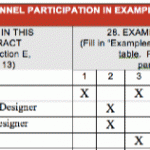 You have your hands on an RFP that is perfect for your firm. You have completed a ton of projects just like the client needs.
You have your hands on an RFP that is perfect for your firm. You have completed a ton of projects just like the client needs.
But there is one gut- wrenching problem. The proposal asks for experience within the last five years. Your relevant projects are over five years old!
Now, you could just throw up your hands and admit defeat. If that’s your plan, stop reading this and go back to your monkey work. You’ve been defeated.
Situations like this separate the proposal monkeys from the knowledge workers. There is no flow chart or form that’s going to get you to this answer. Your knowledge and ability to make connections between abstract concepts will be key here.
Here is how a knowledge worker might address this situation.
Three Ways This Can Play Out
Let’s look at this from a 50,000 foot perspective. You can either:
- Get the RFP language changed.
- Submit anyway.
- Walk away.
I’m going to walk you through each of those items. But you need some background first.
Why Would The Client Make Such A Limit?
One of the concepts I stress in my book is step into the shoes of whoever is writing the RFP. Try to imagine the situation they are in.
Sometimes, language in RFPs is put in there for a reason. The language may be a deliberate attempt to achieve an outcome.
A lot of times, the language is just cut and paste in there from another RFP. Yes, RFPs are created by humans. And not one single human wants to write an RFP from scratch.
You need to consider whether this language was put in there for a deliberate reason or not.
Is It Reasonable To Believe The Limit Is In The Client’s Best Interest?
Determining whether this language is in the client’s best interest might help you come to the answer for “why.” Let me give you some examples.
Let’s say the client asks for “experience designing Olympic stadiums over the last five years.” That severely limits the field to one or maybe two teams. I would consider that not only unreasonable, but unfairly limiting the field.
But what if the client asks for “experience designing college dormitories within the last five years?” Well, that guy or gal will get 100 firms submitting proposals. It doesn’t make a lot of sense for him/her to raise the limit to ten years. Realistically speaking, they are not going to read 100 proposals, let alone 200.
Is it truly in the client’s best interest to raise that limit? That’s the question.
Commitment/Consistency Vs. Social Proof
If you read my What You Don’t Know About Marketing piece, you know that relevant experience is really demonstrating social proof: others in the same situation have chosen your firm.
While you may be lacking social proof, you may have a different weapon of influence to use: Commitment/Consistency.
Simply put, if they have chosen your firm in the past, it is easier for them to choose you again than choose someone new.
If you can make the case that your qualifications, price, and other factors are relatively equal: They are going to feel internal pressure to choose you.
Do We Really Have a Shot?
Sometimes RFP language is written to discourage you from submitting.
If you really don’t have a better than good shot at winning this, you are just wasting your time anyway. The experience limit is irrelevant.
Get The RFP Language Changed
The first option is to get the RFP language changed. Not only have I done this many times, I’ve seen others do it.
Ask a Question
What’s the downside of asking a question in this situation? Nothing!
Ask a formal question. Make a compelling argument to raise the limit to ten years (good luck beyond that).
I go into more detail on how to write a good RFP question in Proposal Development Secrets: Win More, Work Smarter, and Get Home on Time.
Submit Anyway
Assuming you have a reasonable chance, you may choose to submit anyway.
Let’s look at why and how you would do that.
Ambigious RFP Language
“Project experience within the last five years,” is pretty damn ambiguous.
When is a design complete? After you delivered the design? After the last RFI is answered? After the project is built? Once the facility is open and in use? Once your contract is closed out?
There are certainly multiple reasonable interpretations to that statement. Which one you chose is up to you.
Don’t wrongly assume that designers hand off a design then walk away. You know better than that.
How To Frame Your Response
There are three rules to framing your response in this situation.
- Only give them the information they ask for.
- Don’t lie.
- Don’t be stupid.
What Am I Not Allowed To Put In This Proposal?
The question above is critical if you take the submit anyway approach. If this is a 330 form submission, you are limited to ten projects. In this case, placing projects that don’t meet the criteria puts you at risk of being unresponsive.
But let’s say it’s not a form proposal. What’s stopping you from showing a wealth of relevant experience beyond five years? Nothing.
In this situation, you’re certainly not going to pull out a win by being conservative. So, be a little bold. Show the three projects you did within the last five years and the 20 projects you did within the last 10 years.
In reality, would you choose the heart surgeon that has performed five heart bypasses in the last five years or the one who performed 23 heart bypasses in the last 10 years? Personally, I’m going to go with the second one.
Walk Away
The last option is to walk away. It may sound like I discourage this option, but I don’t. If you don’t have a more than good chance of winning this, if your question failed to change the RFP, and if your experience really isn’t that on point: It’s best to just walk away.
Do you have experience with or something to say about this situation? Let us know by posting a comment!





Speak Your Mind